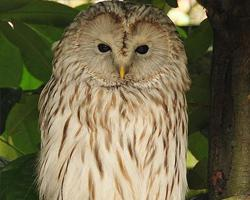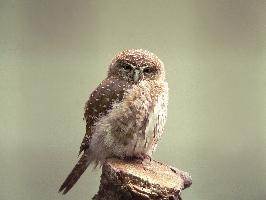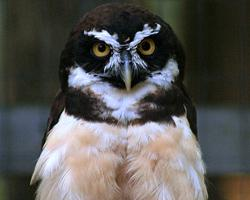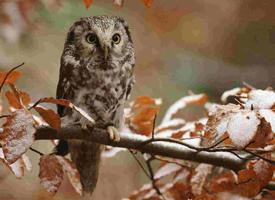
Váhy a míry
| Délka | 60 cm |
|---|---|
| Hmotnost | od 540 do 1200 g |
Stav ohrožení
| Ohrožen |
Popis zvířete
The Ural Owl (Strix uralensis) is a captivating species of owl belonging to the Strigidae family, which encompasses true owls characterized by their distinctive facial discs and asymmetrical ears. Native to the expansive forests of Europe and Asia, particularly thriving in the Ural Mountains from which it derives its name, this owl has adapted to a wide range of forested habitats, from the lowlands to the subalpine zones.Physical Description:
The Ural Owl is a large bird, with a body length typically ranging from 50 to 62 cm (19.7 to 24.4 inches) and a wingspan that can reach up to 115 to 125 cm (45 to 49 inches). It possesses a robust build, with a rounded head devoid of ear tufts, a feature that distinguishes it from some other owl species. Its plumage is predominantly a soft grey with white and darker streaks and spots, providing excellent camouflage against the bark of trees. The facial disc is more pale and distinct, aiding in its nocturnal hunting by funneling sounds to its ears. The eyes are deep and dark, set against a backdrop of a somewhat heart-shaped face, and its beak is sharp and hooked, typical of raptorial birds.
Habitat and Distribution:
Ural Owls are found across a broad swathe of the northern Palearctic region, from Scandinavia across Russia to Japan. Their preferred habitats are extensive, mature forests with a mix of deciduous and coniferous trees, offering both ample hunting grounds and suitable nesting sites. They are adaptable birds that can also be found in smaller woodlands, parklands, and even in urban areas with sufficient tree cover.
Diet and Hunting Behavior:
Primarily nocturnal, Ural Owls embark on hunting forays from dusk till dawn. Their diet is varied and includes a wide range of prey, from small mammals like voles, mice, and shrews to birds, insects, and occasionally fish. They hunt from a perch, using their acute hearing and night vision to detect prey before swooping down silently to capture it with their powerful talons.
Reproduction and Lifespan:
The breeding season for Ural Owls begins in early spring. They are monogamous birds, often forming long-term pair bonds. Nests are typically located in tree cavities, old nests of other large birds, or on specially designed platforms. The female lays between 2 to 5 eggs, which she incubates for about a month while being fed by the male. Once hatched, the chicks are altricial, requiring several weeks of care before they are ready to fledge. Juveniles will remain dependent on their parents for a few more months. Ural Owls can live up to 15 years in the wild, though survival rates are influenced by factors such as predation, habitat loss, and human activity.
Conservation Status:
Currently, the Ural Owl is classified as Least Concern by the International Union for Conservation of Nature (IUCN), thanks to its wide distribution and stable population sizes in many areas. However, they face threats from habitat destruction, particularly logging and the fragmentation of forest areas, which impact their hunting and nesting sites. Conservation efforts are focused on habitat preservation and management, including the maintenance of old-growth forests and the erection of nest boxes to support breeding populations.
In conclusion, the Ural Owl is a remarkable bird, embodying the mystery and majesty of the nocturnal forest. Its presence is a testament to the health and complexity of forest ecosystems, and its conservation is crucial for maintaining the biodiversity of these habitats.
Podobná zvířata
Nové fotografie zvířat
Top 10 zvířat
- Chinese water dragon (Physignathus cocincinus)
- Galápagos tortoise (Geochelone nigra complex)
- Dolphin gull (Leucophaeus scoresbii)
- Japanese macaque (Macaca fuscata)
- Colombian red howler (Alouatta seniculus)
- Sea urchins (Echinoidea)
- Diana monkey (Cercopithecus diana)
- Moustached guenon (Cercopithecus cephus)
- Colossal squid (Mesonychoteuthis hamiltoni)
- Common house mosquito (Culex pipiens)


